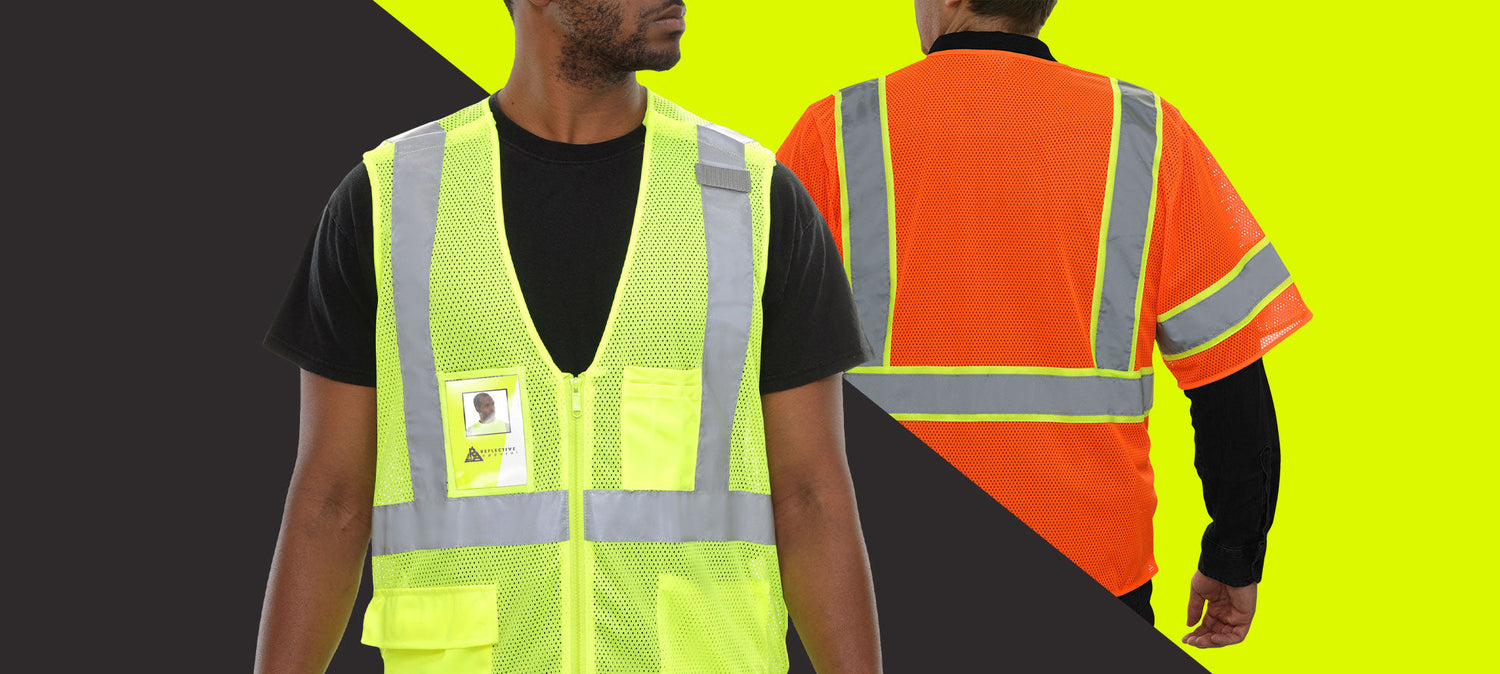High-visibility vests are essential for reducing risk and saving lives by ensuring visibility in potentially hazardous environments. The most commonly used safety vests are Class 2 and Class 3, each designed for specific levels of risk and visibility requirements. Understanding the difference between class 2 and class 3 safety vests is crucial for selecting the right vest to meet workplace safety standards.
What Are Safety Vests?
Safety vests are high-visibility garments designed to make workers easily noticeable in low-light or high-risk environments. Constructed from bright, fluorescent materials with reflective elements, these vests ensure wearers stand out against any background. This visibility is especially critical for individuals working near moving vehicles, heavy equipment, or in busy work zones.
The American National Standards Institute (ANSI) provides guidelines on visibility levels, reflective material requirements, and essential design features for safety vests to enhance safety in different work environments. Safety vests are ANSI compliant when they meet the requirements specified in the ANSI/ISEA 107-2020 standard for high-visibility safety apparel (HVSA). The ANSI/ISEA 107 standard determines classes of safety vests (Class 1, Class 2, and Class 3) based on the background and retroreflective material used and the garment's design.
Class 1 Safety Vests
Class 1 safety vests offer the lowest level of visibility and are intended for use in low-risk environments where workers are safely separated from moving vehicles or equipment. These vests are designed for areas where traffic speeds do not exceed 25 mph, and the chances of accidents are minimal. Class 1 vests are ideal for jobs in controlled environments such as parking lots, where workers like parking attendants or cart retrievers need visibility but are not exposed to significant traffic hazards.
Key Features:
- Minimum 217 square inches of fluorescent material.
- At least 155 square inches of retroreflective tape are arranged for basic visibility.
- Simple, lightweight design, often sleeveless with reflective strips across the chest and shoulders.
Class 2 Safety Vests
Class 2 safety vests are designed for environments where the risk of being struck by vehicles is moderate, typically with speeds between 25 and 50 mph. These vests offer enhanced coverage and reflective material compared to Class 1, making them suitable for workers who need to be seen more prominently. Class 2 safety vests are commonly worn by road construction workers, warehouse operators, parking lot attendants, and toll booth workers. Their enhanced visibility ensures safety when traffic or equipment poses moderate risks.
Key Features:
- At least 775 square inches of background material.
- Minimum 201 square inches of reflective tape strategically placed for high visibility.
- Larger design for greater coverage, typically including reflective strips on the front, back, and sides.
Class 3 Safety Vests
Class 3 safety vests provide the highest level of visibility and are designed for high-risk environments, such as areas with fast-moving traffic exceeding 50 mph or during low-light conditions. These vests offer maximum coverage and are engineered to ensure workers are visible from all angles, even at a distance. Class 3 safety vests are essential for roadway construction crews, emergency responders, utility workers, and school crossing guards. Their design ensures maximum visibility, reducing risks in environments where worker safety depends on being seen from far away or in poor weather.
Key Features:
- A minimum of 1,240 square inches of background material.
- At least 310 square inches of retroreflective material, typically arranged across the arms, chest, back, and legs.
- Includes sleeves or full-body coverage for enhanced visibility in poor lighting or hazardous conditions.
Difference Between Class 2 and Class 3 Safety Vests
Most industry standards require ANSI Class 2 and ANSI Class 3 compliant safety gear. Here is a table showing the differences between Class 2 and Class 3 safety vests to help you decide which is right for your work environment.
|
Feature |
Class 2 Safety Vest |
Class 3 Safety Vest |
|
Minimum Background Material |
775 sq. in. (0.50 m²) |
1,240 sq. in. (0.80 m²) |
|
Minimum Retroreflective Material |
201 sq. in. (0.13 m²) |
310 sq. in. (0.20 m²) |
|
Design Requirements |
Sleeveless vests or short-sleeve garments |
Garments with sleeves |
|
Visibility Level |
High visibility |
Highest visibility |
|
Traffic Speed Exposure |
Exceeds 25 mph (40 km/h) |
Exceeds 50 mph (80 km/h) |
|
Intended Use |
Workers near traffic up to 50 mph, construction crews, utility workers, survey crews |
Workers in high-risk environments, emergency responders, flaggers, and workers in poor weather conditions |
|
Coverage |
Provides visibility of the torso |
Provides 360-degree visibility |
Frequently Asked Questions
What Are the Main Differences Between Class 1, Class 2, and Class 3 Safety Vests?
- Class 1: Designed for low-risk environments with minimal traffic moving at speeds below 25 mph. Provides basic visibility with the least amount of high-visibility and reflective material.
- Class 2: Suitable for environments where traffic speeds exceed 25 mph but are less than 50 mph. Offers increased visibility with more high-visibility and reflective materials than Class 1.
- Class 3: Intended for high-risk environments with traffic speeds exceeding 50 mph or in poor visibility conditions. Provides the highest level of visibility, covering the torso, arms, and sometimes legs.
When Should I Choose a Safety Vest Class 2 Vs. a Safety Vest Class 3?
Choose a Class 2 vest when working near roadways with traffic speeds between 25 and 50 mph or in environments where enhanced visibility is necessary but full 360-degree visibility is not critical. Class 3 vests are recommended for high-speed traffic areas or situations requiring maximum visibility.
Are Class 1 Safety Vests ANSI Compliant?
Class 1 safety vests are ANSI compliant if they meet the ANSI/ISEA 107-2020 standard requirements. Compliance ensures the vest has the appropriate high-visibility and reflective material and meets design specifications. Non-ANSI vests, such as enhanced visibility vests, are also used for low-risk conditions.
How Can I Verify if a Safety Vest is ANSI-Compliant?
Check the vest's labeling. ANSI-compliant vests should have a label stating compliance with ANSI/ISEA 107-2020, including the specific class (Class 1, 2, or 3) and other relevant information about the garment's performance.
What is ANSI/ISEA 107-2020?
ANSI/ISEA 107-2020 is a standard that specifies the requirements for high-visibility safety apparel. It outlines the design, materials, and photometric requirements to ensure workers' visibility in various work environments.
Can I Wear a Class 2 Vest in a Class 3 Environment?
A Class 3 garment is needed to comply with safety regulations.
Do the Colors of High-Visibility Safety Clothing Matter?
High-visibility apparel is produced in bright fluorescent colors (fluorescent lime-yellow or orange) to enhance optimal visibility in the daytime, while reflective tapes protect at night.
Who Typically Needs to Wear Class 3 Safety Vests?
Workers in high-risk environments, such as highway construction crews, emergency responders, flaggers, and utility workers in high-speed traffic, must wear Class 3 safety vests.
Are There Specific Requirements for Safety Vests in Adverse Weather Conditions?
Class 3 garments are recommended in poor weather conditions as they provide maximum visibility. Some vests are designed with weather-resistant materials to maintain visibility and durability in adverse conditions.
What Other High Visibility Safety Apparel Should I Consider?
In addition to safety vests, you should consider other high-visibility clothing and protective equipment to enhance your safety, such as high-visibility jackets, shirts, and pants. High-visibility rain gear is also essential for maintaining visibility during inclement weather conditions. In contrast, accessories like high-visibility hard hats, gloves, reflective stripes, and reflective arm or leg bands can further augment your visibility. These items help you meet safety standards and ensure you're seen from all angles, especially in low-light or high-risk environments.







